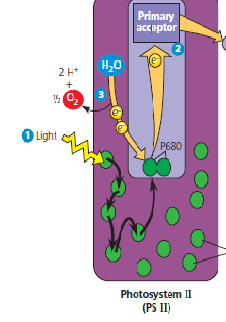Where does the oxygen released by plants during photosynthesis comes from?
1 Answer
The oxygen comes from the splitting of water.
Explanation:
During photosynthesis, light will hit pigment cells in photosystem II. The cells absorb this energy which is transferred from cell to cell until the P680 pair of chlorophyll molecules absorb it. An electron in this pair of molecules then becomes excited because of this extra energy, leaves the molecule and is transferred to the primary electron acceptor.
The movement of this electron leaves something like a 'hole' in the molecule that needs to be filled. While all this is going on, there's an enzyme that's splitting water molecules to give electrons, hydrogen and oxygen.
Remember that water's chemical formula is
Oxygen is just a by-product of this splitting, and will be removed from the plant.

This diagram sums up everything. The black arrows show the energy movement from the pigments to the P680 molecule. An electron travels up to the primary acceptor and is replaced with incoming ones from

